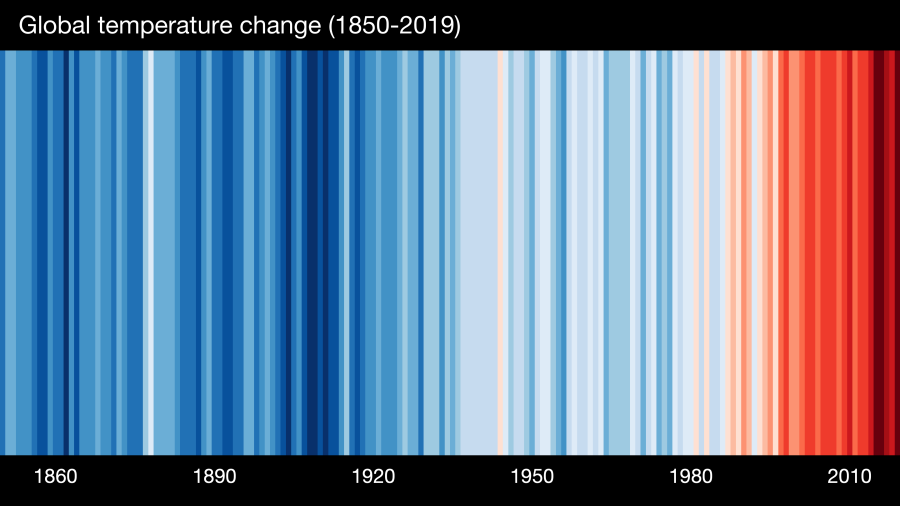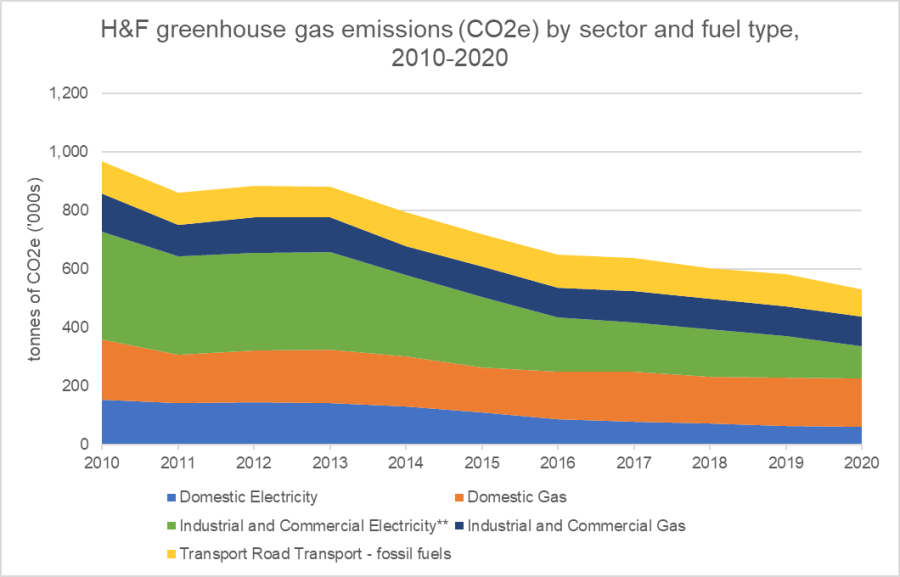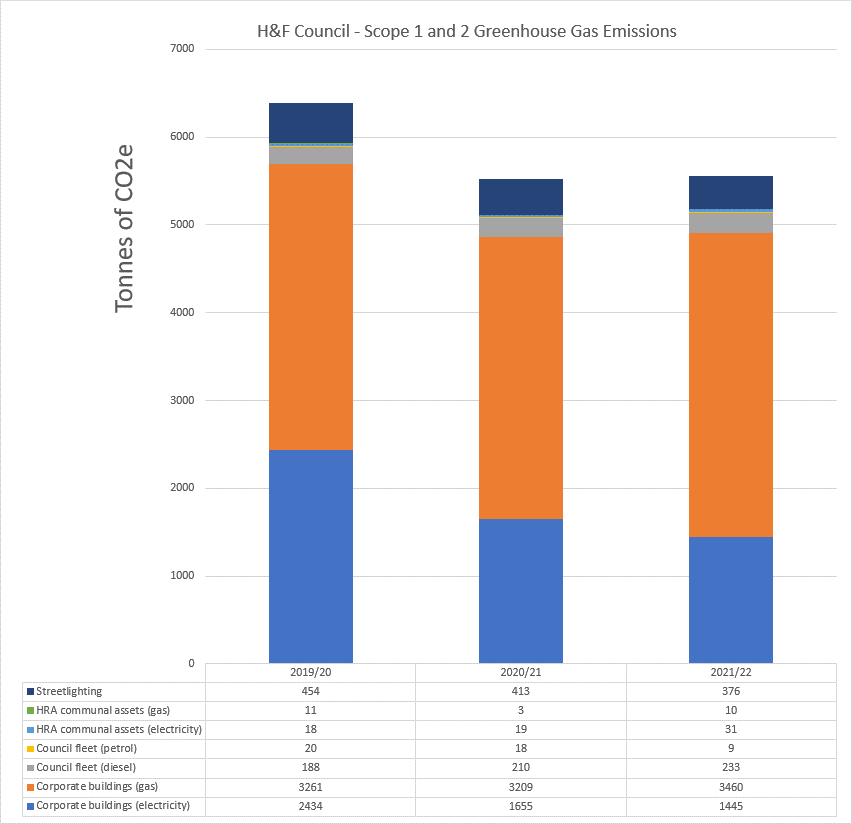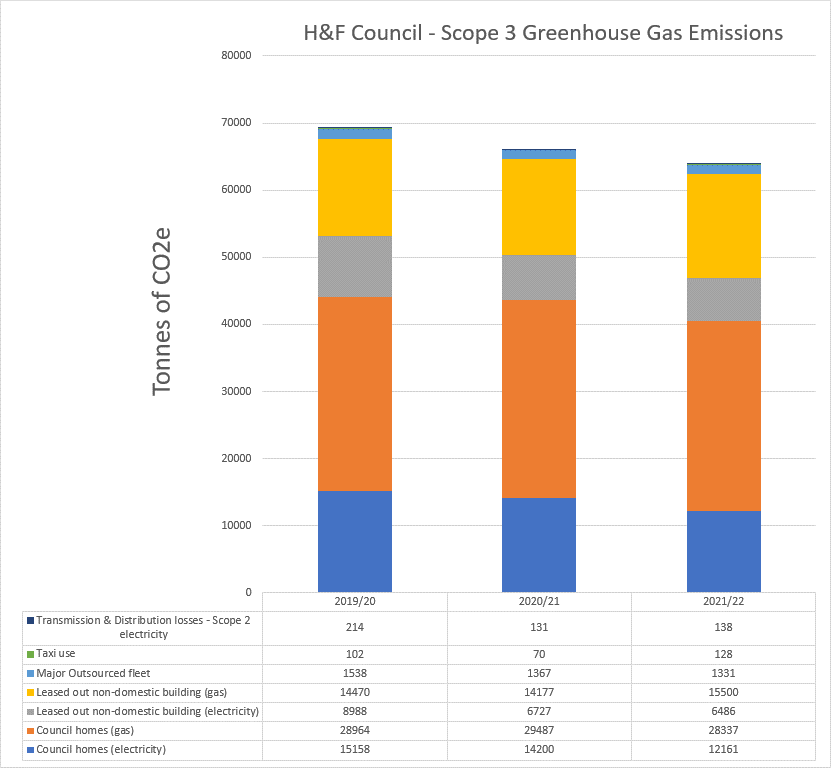In 2019 H&F Council declared a climate and ecological emergency. Find out more about what this is below and explore local impacts and risks.
Want to find out more? Book H&F Council to give a lunch and learn on local impacts of climate change with your group or organisation.
What is the climate emergency?
Climate change is being caused by human activity emitting greenhouse gases.
The main causes of climate change are:
- burning fossil fuels (like petrol, diesel and gas) for energy
- deforestation
- farming
- the manufacture of cement, metals and chemicals.
Over the past 100 years, human activity has significantly increased the amount of greenhouse gases in the atmosphere. This has enhanced the 'greenhouse effect' heating the atmosphere and oceans, destabilising the climate and endangering people and the planet.
The world has already warmed by 1°C since records began (more over land where people live). The ten hottest years ever recorded in the UK have all occurred since 2002.
The UN reports that we must take radical action by 2030 to keep climate change within safe levels. Beyond this, catastrophic and irreversible change is expected.
Yet as of 2019 the amount of greenhouse gases we are emitting continues to rise. The action planned in the UK to date is not enough to meet its climate commitments.
That's why in 2019, H&F Council declared a climate emergency. We set an ambitious target to reach net zero carbon emissions by 2030 for our borough.
Average global temperatures

This 'warming stripe' graphic is a visual representations of the global average temperature from 1850 to 2019. Each vertical stripe represents one year. Cooler years are blue and hotter years are red.
This image shows that average temperatures have increased rapidly over the past 10-15 years. As of 2018, the 20 warmest years on record globally have been in the past 22 years.
Find our more about the warming stripes graphic.
What is the ecological emergency?
Biodiversity is another world for "life on earth". The natural world provides food, health, wellbeing and solutions to climate change. You can think of biodiversity as the foundation for our entire economy.
Yet world-leading scientists worry that we are on the cusp of a sixth global mass extinction.
- 1 in 4 species are at risk of extinction
- Species populations have decreased by over 60% since the mid-20th century
We have known about this problem for some time and there have been previous attempts to conserve wildlife and restore nature. Yet even with these efforts we have not reached these global targets.
As humans, we are responsible for this drastic decline in biodiversity. There are 5 main causes. These causes lie close to home and are explained below.
1. Habitat loss and degradation - Losing gardens and hedgerows is causing a swift decline in many iconic British species. We have lost 97% of hedgehogs in the UK since the 1960s.
2. Pollution - The Thames has some of the highest levels of microplastic pollution in the world.
3. Exploitation - Overexploitation of native oysters has led to a 95% decline in their population size.
4. Invasive species and disease - You may have seen parakeets in London. These were introduced by people and have a detrimental impact on many of our native birds.
5. Climate change - 48% of UK moth populations have declined as a result of changing weather patterns.
H&F Council are one of the only councils to declare an ecological emergency. It is not too late to restore biodiversity if we act now.
Local impacts
There are three main risks of climate change in H&F. Investment in climate resilience today will help avoid costs from an extreme and changing climate.
Flooding
Flooding poses grave risks to life, homes, infrastructure and mental health.
Most of our borough is at risk from surface water flooding as increasing rainfall levels are recorded almost every year.
As a low lying borough H&F is also at risk of flooding from sea level rise.
Extreme heat
Hammersmith & Fulham is vulnerable to extreme heat. Our density of buildings creates an 'urban heat island' that can be up to 10°C hotter than outside London.
During the heatwave in 2020 Hammersmith Bridge was closed to all traffic after the bridge fractures were aggravated by extreme heat. We can expect heatwaves like that of August 2020 every other year by mid-century.
Extreme heat puts older adults, young children and disabled residents most at risk. Heat-related deaths in the UK are projected to rise five times to over 12,000 per year by 2080.
Drought
London is at risk from drought, with a shortfall of water supply projected to reach 400m litres per day by 2040.
Droughts impact health, business, infrastructure and amenities; the cost to London of extreme drought is estimated at over £330m per day.
Local greenhouse gas emissions
The borough's greenhouse gas emissions
The borough's emissions have reduced by 46% since 2010 (source: London Energy and Greenhouse Gas Inventory. Minor sources totalling 5% of emissions have been removed for visual clarity).

The council's greenhouse gas emissions
The council's scope 1 and 2 emissions (from the assets and operations it directly controls) have reduced by 17% since the baseline year of 2019/20.

Open larger image of H&F Council - Scope 1 and 2 greenhouse gas emissions
The council's scope 3 greenhouse gas emissions (from assets and operations outside its direct control but within its influence) have reduced by 8% since 2019/20.

Open larger image of H&F Council - Scope 3 greenhouse gas emissions